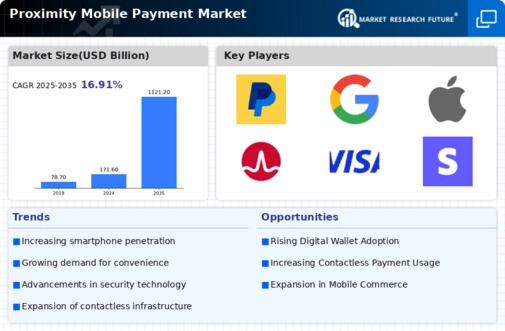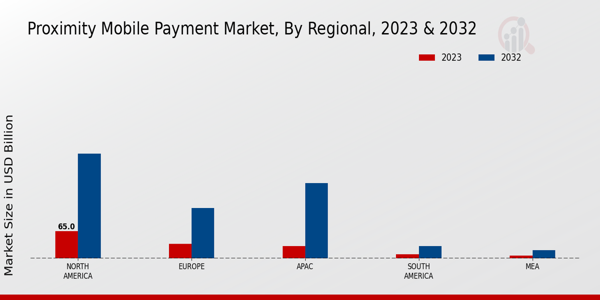E-commerce Growth
The rapid expansion of the e-commerce sector is significantly contributing to the growth of the Global Proximity Mobile Payment Market Industry. As online shopping becomes increasingly popular, the demand for efficient and secure payment methods rises correspondingly. In 2024, e-commerce sales are projected to reach new heights, further driving the need for mobile payment solutions that facilitate quick transactions. Retailers are increasingly integrating proximity payment options into their platforms to enhance customer experience. This trend is expected to continue, with the market potentially reaching 1121.2 USD Billion by 2035, driven by the synergy between e-commerce and mobile payment technologies.
Market Growth Projections
The Global Proximity Mobile Payment Market Industry is poised for substantial growth, with projections indicating a market value of 171.6 USD Billion in 2024 and an anticipated rise to 1121.2 USD Billion by 2035. This trajectory suggests a compound annual growth rate (CAGR) of 18.6% from 2025 to 2035. Such growth is likely driven by factors including technological advancements, increasing smartphone penetration, and changing consumer preferences towards contactless payments. The market's expansion reflects a broader trend towards digitalization in financial transactions, indicating a transformative shift in how consumers engage with payment systems globally.
Technological Advancements
The Global Proximity Mobile Payment Market Industry is experiencing rapid growth due to continuous technological advancements. Innovations in Near Field Communication (NFC) and QR code technologies facilitate seamless transactions, enhancing user experience. For instance, the integration of biometric authentication methods, such as fingerprint and facial recognition, is becoming commonplace, thereby increasing security and consumer confidence. As of 2024, the market is valued at approximately 171.6 USD Billion, indicating a robust demand for these technologies. This trend is likely to continue, as advancements in mobile device capabilities and payment infrastructure evolve, further driving the adoption of proximity mobile payments.
Increasing Smartphone Penetration
The proliferation of smartphones globally is a key driver of the Global Proximity Mobile Payment Market Industry. With an estimated 6.8 billion smartphone users worldwide in 2024, the accessibility of mobile payment solutions has surged. This widespread adoption allows consumers to utilize their devices for transactions, thereby fostering a shift from traditional payment methods to mobile payments. The convenience offered by mobile wallets and payment applications is appealing to consumers, particularly in urban areas. As smartphone penetration continues to rise, it is anticipated that the market will expand significantly, potentially reaching 1121.2 USD Billion by 2035.
Supportive Government Initiatives
Government initiatives aimed at promoting digital payments are playing a crucial role in the expansion of the Global Proximity Mobile Payment Market Industry. Various countries are implementing policies to encourage cashless transactions, thereby enhancing financial inclusion. For example, initiatives such as tax incentives for businesses adopting mobile payment systems and public awareness campaigns about the benefits of digital payments are becoming more prevalent. These efforts not only foster consumer trust but also stimulate market growth. As governments worldwide continue to support digital payment ecosystems, the market is expected to flourish, aligning with the projected growth trajectory.
Consumer Preference for Contactless Payments
There is a noticeable shift in consumer behavior towards contactless payment methods, which is significantly influencing the Global Proximity Mobile Payment Market Industry. As consumers prioritize convenience and speed in their transactions, contactless payments have gained traction. This trend is particularly evident in retail environments, where quick service is essential. According to recent data, approximately 70% of consumers express a preference for contactless payments over traditional methods. This growing inclination is likely to propel the market forward, with projections indicating a compound annual growth rate (CAGR) of 18.6% from 2025 to 2035, reflecting the increasing demand for efficient payment solutions.















